The importance of the properly chosen Keyword is essential. In order to choose a keyword for our article, we can use one of the keyword planners. One of them is the tool coming directly from Google and it is for free.
I have done research about Google’s keyword planner and came up with the following tutorial or brief guideline.
Just a note; Previously this tool was called Google Keyword Tool.
Please note that the tool is directly connected to Google Ads (formerly known as Google Adwords).
Since we are interested in organic traffic only (meaning we will not run any paid campaigns) we don’t have to go through all features.
How to use the Google Keyword Planner
When you want to access the Google Keyword Planner, the first thing you need to do is to create an account inside Google Ads.
If you don’t have one, just click on the link and follow the simple process.
Once you are inside the Google Ads, hover over the tools icon, and on the left-hand side under planning go to Keyword Planner.
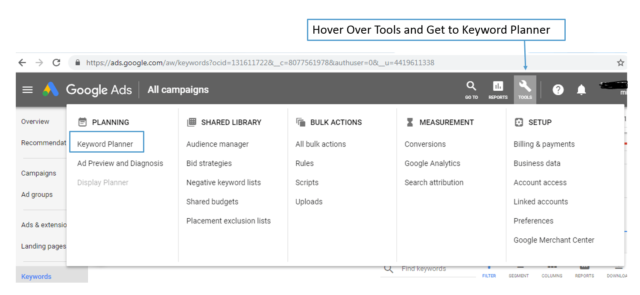
Find New Keywords or Get Search Volume and Forecasts
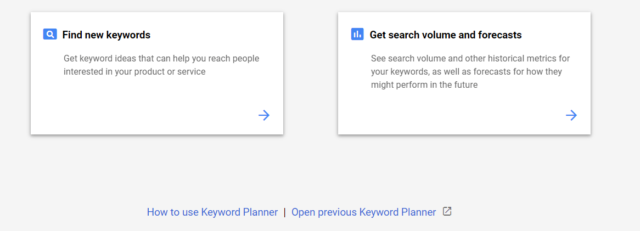
You have now two tools available.
- Find new Keywords. Here you get ideas for new keywords. You enter your keyword and based on that you get a list of similar keywords, which may help you to get people to your site.
- Get Search volume a forecast. After entering your keyword you see useful data regarding only this specific keyword.
So if you have a certain keyword you want to use in your article you can go to option #1 to check whether you find better keywords (like brainstorming). You never know, right? Then pick up those you like the most and run them through option #2 to see what metrics they show you.
Based on these data (like performing in the future or Average monthly searches) you will be able to determine what are the best KW for your business (blog post or so.)
So let’s take a look a little bit deeper into both tools.
Find New Keywords – Keywords Ideas
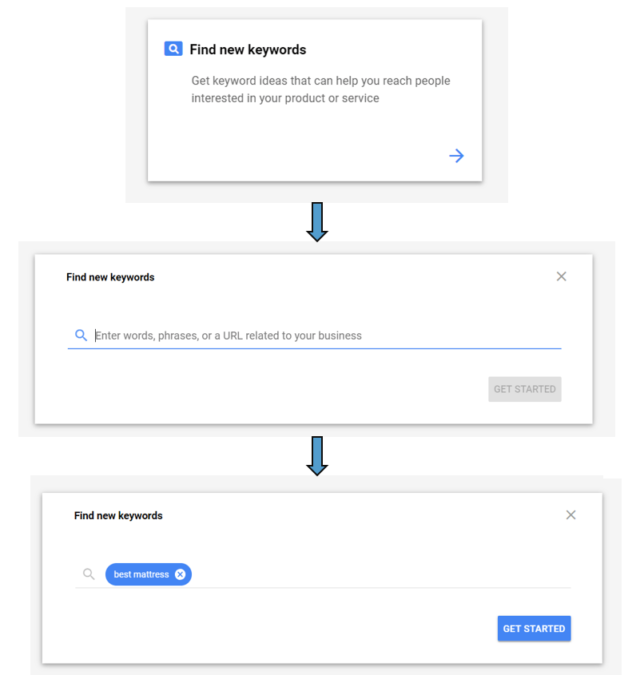
Keywords, it is not only mean a single word. As suggested you are free to use phrases or a combination of more keywords/phrases.
Here is how it looks at the Keyword Ideas page. Depending on the location you want to target, make sure that you have chosen the correct filter for, location, language, and search network (here you have 2 possibilities: Google or Google and search partners, like for example YouTube.)
TIP: Set Google, only.
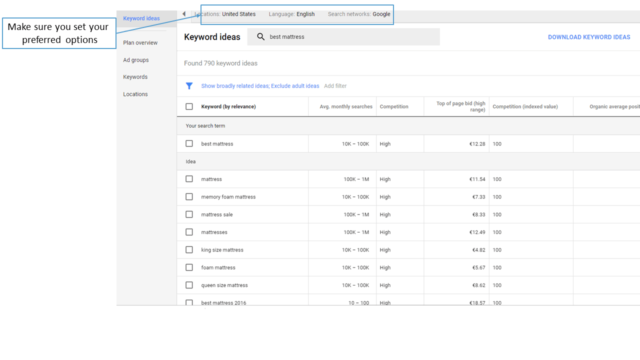
For each Keyword Idea you see:
- Avg. monthly searches – This is a figure that most people complain about. In the former platform, the numbers were much more exact. Nowadays you see the range. That means that if one keyword gets 100 searches in let’s say May, and 1,000 in October you will get a pretty wide range. You will see, though, how to get more accurate data a bit later 😉
- Competition – Number of advertisers making an offer on that specific keyword.
- Top of Page bid – The number of what advertisers are willing to pay for a keyword in order to get to the top position. Based on historical data (in regards to paid ads). A higher price means more difficult to get to the top of the page.
Get Search Volume and Forecast
Here is where you get the important data regarding your specific word.
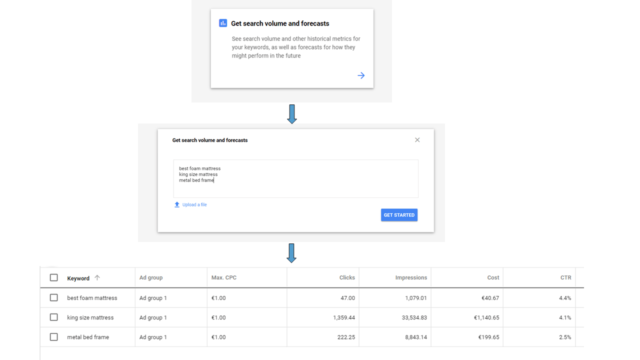
Or a bunch of keywords you can upload from a file you already have saved.
These data are very useful for somebody who runs advertisers, using paid Ads. As we said, that is not us.
So we better take a look at the Historical metrics, where we get to see the average search volumes for our list.

Oh, again this range. It does not help us much.
No worries.
Below we describing the workaround, where you get to see the exact search volumes.
Choosing the Keyword
Finding the best keyword is not an exact science. You might need a bit of practice to get that right feeling for the best keyword. But do not worry.
Let’s say you want to write a post about a mattress. Or you are in affiliate marketing and you do reviews about mattresses. You want to know how many people search for a chosen keyword. The thing is, not to start with a too broad word like ” mattress “.
You want to narrow it down a bit.
Your keyword might be “king-size mattress”.
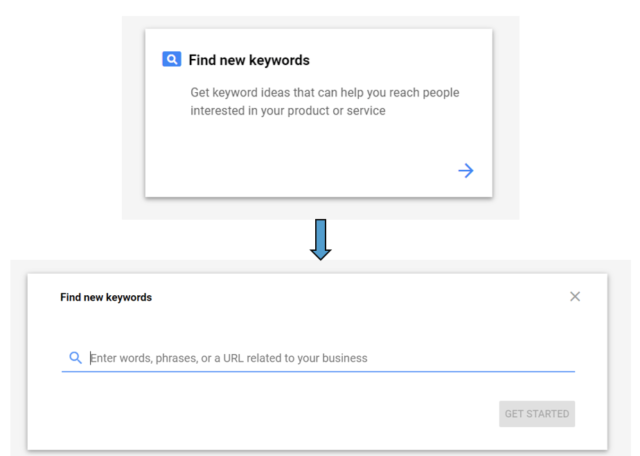
Go to the beginning as we are already familiar with:
Here is the list of suggested keywords with some factors.
We are interested in the
- Avg. monthly searches (or Search Volume)
- Competition
(These are the very same factors we want to see when we search for KW in Jaaxy – Avg & QSR)
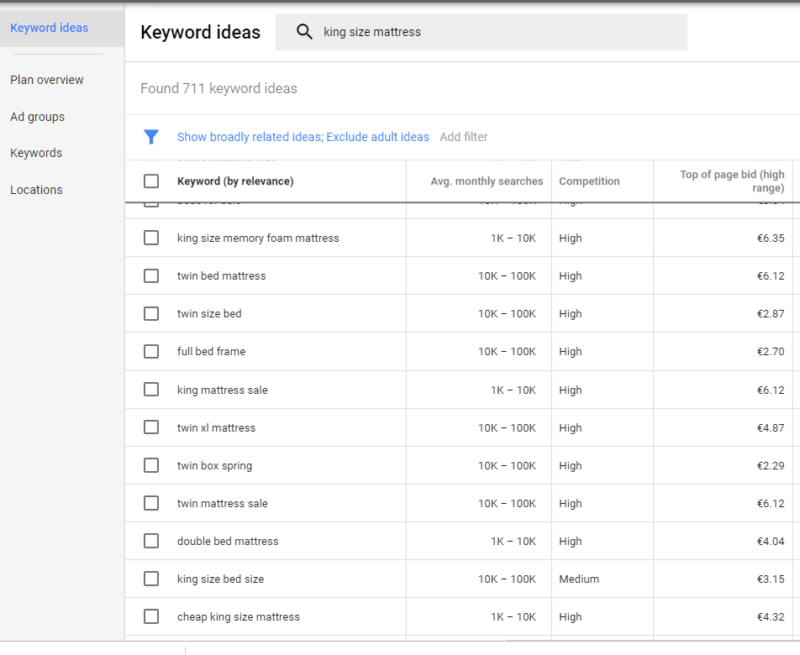
How to get the specific search volume for our keyword?
Let’s pick one of the keywords we want to check – “king-size memory foam mattress” That looks like a specific keyword to me.
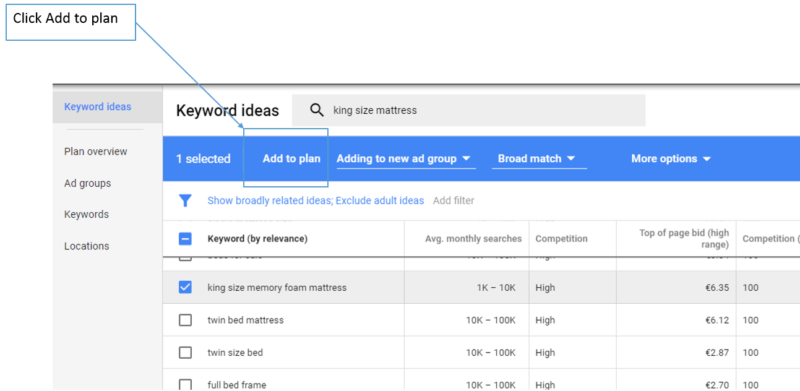
By clicking on the Plan overview, we call for the exact data as per the screenshot below:
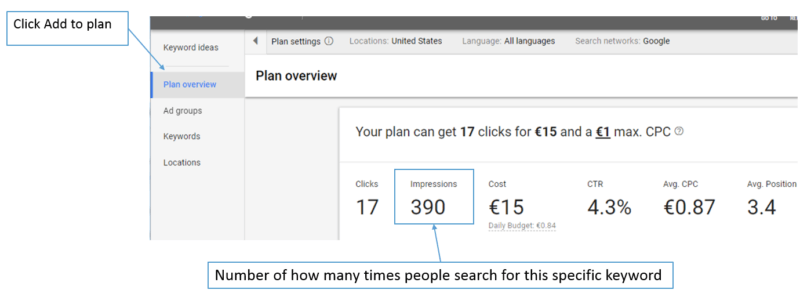
3 Secret Tips
Exact Search Volumes
There are Keyword Research Tools, where you see the exact search volume right away. It is not the case at GKP (Google Keyword Planner), and therefore many SEOs stopped using this tool.
Let’s see how many clicks you might get once you are on the 1st page. Because this is one of the numbers we are interested in – we want to know the estimated number of visitors to our site, because of the specific keyword.
The way how to find out the data is pretty much the same as shown above paragraph (Real Example – Choosing the Keyword).
Well here is a little tricky thing;
The search result we got above is limited by the theoretical budget (it is always related to Google Ads so it deals with the theoretical cost you are willing to pay for a specific keyword).
That means that if you do not want to spend more than €0,84 a day per that keyword, your site will be visible only 390 times and will get possible 17 clicks.
But we are learning how to get our site on the 1st page.
So Let’s say that we have already an authoritative site and we rank on the #1 top page in Google, organically.
How many clicks would we get? The maximum possible number, right; since we are #1 in search results.
So how to simulate such a situation? We can do that by a little drop-down menu and set the clicks at the maximum possible value.
Please make sure that you got to Full-Screen mode.
When we compare the exact keyword with our favorite keyword research tool Jaaxy, we see that the results are pretty close.
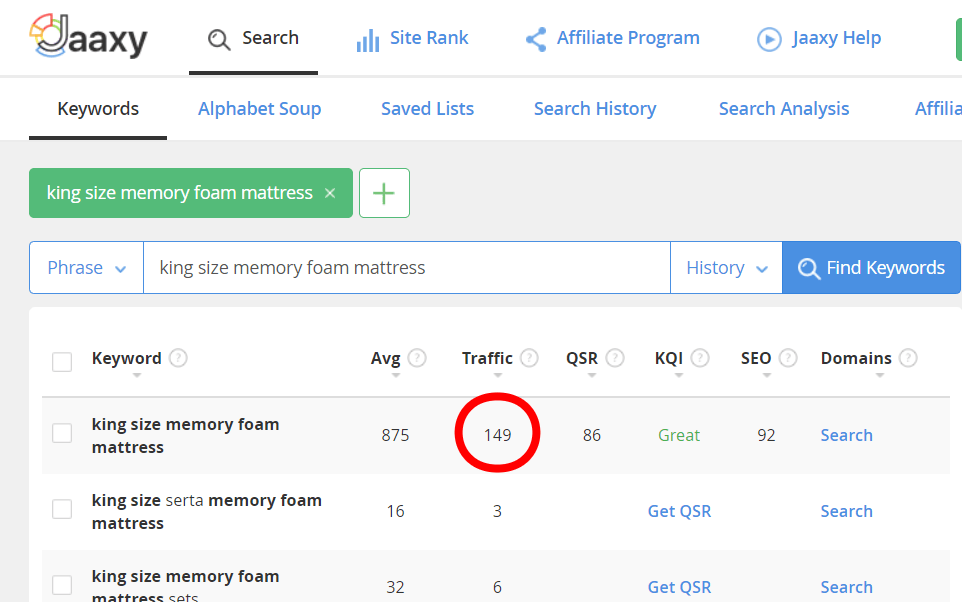
The thing is that whereas GKP shows us forecast data for the next 30 days, Jaaxy shows us results based on historical data.
Take advantage of your competition
You probably have noticed the option of putting the URL in the “Find new Keywords” window at the very beginning, haven’t you?

Well, GKP is able to create a list of keywords based on the URL. You can take advantage of this feature and observe what KWs your competition uses. Let’s see how many KW ideas we can get from a single URL:
Google a specific KW, and see competitor site.
Running them through the GKP you get thousands of KW ideas. You can then play around with the filters like for example to exclude some keywords text.
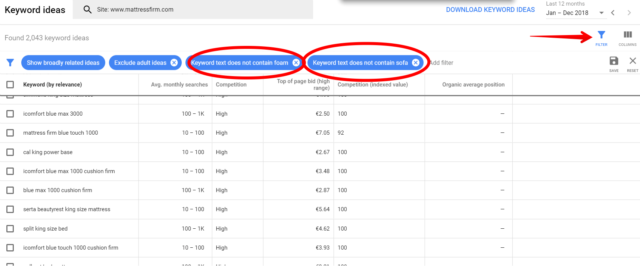
Note 1:
You have more options while entering the URL into the search bar of the “Find new keywords” bar.
The results will be for the entire site, or for the specific page only.
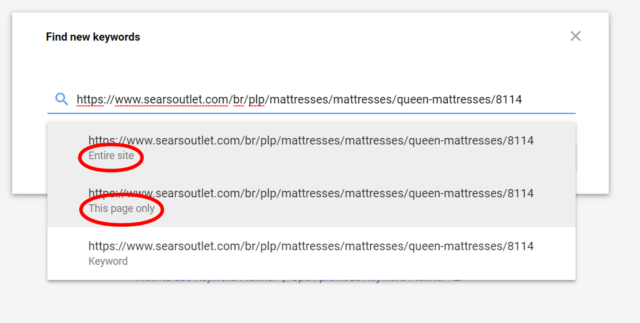
Note 2:
You can enter only one site at a time.
What Audience is Asking
Have you ever felt like you run out of ideas for content writing? In such cases, brainstorming is a very helpful tool. That particular tool can be found as part of Jaaxy or also with a little trick, you can get ideas out of GKP.
By this time I am sure you are already familiar with the tool, so it’ll be nothing new for you. We are going to use the Filter inside the Keyword Ideas. This time we focus on questions. What possible questions the potential visitors might ask? For you, it is enough to remember the 5x W rule.
- What
- Where
- When
- Why
- Who
You will use one or all of them in the filter, which will look like this:
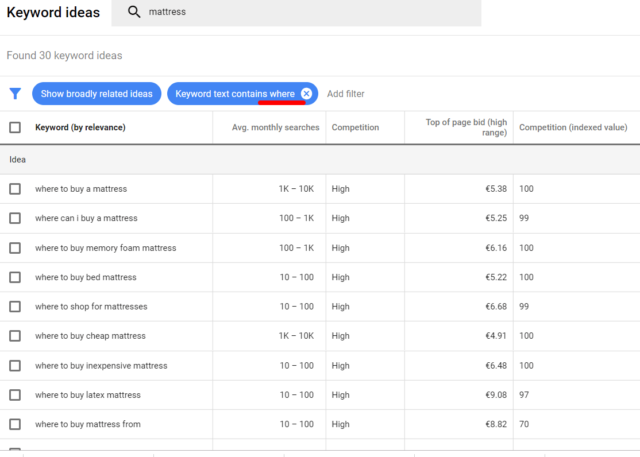
You can also choose a different keyword and combine it with all five W questions. Then you will have an idea about the subject to write about.
Conclusion
When I started to work on my website I wanted to have good results and quick. So I jumped into Google Ads and started to learn about keywords and bidding and what position to be and so on.
Later I found out, that I have to be more patient, and most importantly I need to learn more about how to drive organic traffic to my website before I run out of my budget.
The key aspect of the organic traffic is the keyword and mainly, keyword research tool.
Google Keyword Tool is certainly a good one and most importantly, it is free.
How about your experience with Google Keyword Planner? Do you use the GKP for your research or you prefer a different tool?
Let me know in the comment section below.

Ha! how cool, I’ve actually been struggling a little bit with keywords for my website to attract more people and stuff, so thanks for this. I like your site also. Can’t wait to see the coming content, I added it to my favorite ones so I can check and get tips from it.
Thank you Maria for your feedback.
I appreciate it.
So far I have only used Jaaxy keyword tool for all the keyword research I do for my website. After reading this article it looks like Google Keyword Planner is a bit more better and convenient than the Jaaxy Keyword tool. The great thing is that Google Keyword Planner is totally free and I’m definitely going to utilize it for my upcoming contents.
Thank you so much for sharing this article.
Yes GKP is for free which is great and so I use it as “second opinion” when it comes to keyword research. My #1 is still Jaaxy – I like having everything right at one place.
This is a great read. Up to this point, I have exclusively used Jaaxy to find my keywords. I have been having difficulty finding keywords that make me want to write a post. I will bookmark this page so I can remember to use Google Ads.
It looks like you get the same hit results in both GKR and Jaaxy, but what is your opinion of the keywords generated? Which one generates a better list?
I am looking to improve my content and any input on GKR would be greatly appreciated.
Cheers!
It is always good to have different opinion. In GKP you can check historical data and also forecast. I am not sure how accurate that might be. But it is at least good as estimation.
In my opinion Jaaxy is more conservative with the data. I tend to lean towards Jaaxy as I prefer thisconservative approach. (And I am used to working with Jaaxy 🙂 )